[English] 日本語
 Yorodumi
Yorodumi- PDB-2zm3: Complex Structure of Insulin-like Growth Factor Receptor and Isoq... -
+ Open data
Open data
- Basic information
Basic information
| Entry | Database: PDB / ID: 2zm3 | ||||||
|---|---|---|---|---|---|---|---|
| Title | Complex Structure of Insulin-like Growth Factor Receptor and Isoquinolinedione Inhibitor | ||||||
 Components Components | Insulin-like growth factor 1 receptor | ||||||
 Keywords Keywords | TRANSFERASE / IGFR / protein-inhibitor complex / tyrosine kinase / ATP-binding / Cleavage on pair of basic residues / Disease mutation / Glycoprotein / Membrane / Nucleotide-binding / Phosphoprotein / Polymorphism / Receptor / Transmembrane / Tyrosine-protein kinase | ||||||
| Function / homology |  Function and homology information Function and homology informationprotein kinase complex / insulin-like growth factor receptor activity / insulin-like growth factor binding / Signaling by Type 1 Insulin-like Growth Factor 1 Receptor (IGF1R) / protein transporter activity / IRS-related events triggered by IGF1R / transcytosis / insulin receptor complex / insulin-like growth factor I binding / positive regulation of protein-containing complex disassembly ...protein kinase complex / insulin-like growth factor receptor activity / insulin-like growth factor binding / Signaling by Type 1 Insulin-like Growth Factor 1 Receptor (IGF1R) / protein transporter activity / IRS-related events triggered by IGF1R / transcytosis / insulin receptor complex / insulin-like growth factor I binding / positive regulation of protein-containing complex disassembly / insulin receptor activity / alphav-beta3 integrin-IGF-1-IGF1R complex / dendritic spine maintenance / regulation of JNK cascade / peptidyl-tyrosine autophosphorylation / insulin binding / amyloid-beta clearance / Respiratory syncytial virus (RSV) attachment and entry / insulin receptor substrate binding / SHC-related events triggered by IGF1R / phosphatidylinositol 3-kinase binding / negative regulation of MAPK cascade / insulin-like growth factor receptor signaling pathway / insulin receptor binding / cellular response to glucose stimulus / phosphatidylinositol 3-kinase/protein kinase B signal transduction / receptor protein-tyrosine kinase / cellular response to amyloid-beta / insulin receptor signaling pathway / positive regulation of cold-induced thermogenesis / protein autophosphorylation / protein tyrosine kinase activity / Extra-nuclear estrogen signaling / positive regulation of phosphatidylinositol 3-kinase/protein kinase B signal transduction / receptor complex / positive regulation of MAPK cascade / immune response / cilium / positive regulation of cell migration / axon / intracellular membrane-bounded organelle / positive regulation of cell population proliferation / negative regulation of apoptotic process / nucleolus / signal transduction / ATP binding / identical protein binding / membrane / plasma membrane Similarity search - Function | ||||||
| Biological species |  Homo sapiens (human) Homo sapiens (human) | ||||||
| Method |  X-RAY DIFFRACTION / X-RAY DIFFRACTION /  SYNCHROTRON / SYNCHROTRON /  MOLECULAR REPLACEMENT / Resolution: 2.5 Å MOLECULAR REPLACEMENT / Resolution: 2.5 Å | ||||||
 Authors Authors | Xu, W. / Mayer, S.C. / Boschelli, F. / Johnson, M. / Dwyer, B. | ||||||
 Citation Citation |  Journal: Bioorg.Med.Chem.Lett. / Year: 2008 Journal: Bioorg.Med.Chem.Lett. / Year: 2008Title: Lead identification to generate isoquinolinedione inhibitors of insulin-like growth factor receptor (IGF-1R) for potential use in cancer treatment Authors: Mayer, S.C. / Banker, A.L. / Boschelli, F. / Di, L. / Johnson, M. / Kenny, C.H. / Krishnamurthy, G. / Kutterer, K. / Moy, F. / Petusky, S. / Ravi, M. / Tkach, D. / Tsou, H.R. / Xu, W. | ||||||
| History |
|
- Structure visualization
Structure visualization
| Structure viewer | Molecule:  Molmil Molmil Jmol/JSmol Jmol/JSmol |
|---|
- Downloads & links
Downloads & links
- Download
Download
| PDBx/mmCIF format |  2zm3.cif.gz 2zm3.cif.gz | 257 KB | Display |  PDBx/mmCIF format PDBx/mmCIF format |
|---|---|---|---|---|
| PDB format |  pdb2zm3.ent.gz pdb2zm3.ent.gz | 208.6 KB | Display |  PDB format PDB format |
| PDBx/mmJSON format |  2zm3.json.gz 2zm3.json.gz | Tree view |  PDBx/mmJSON format PDBx/mmJSON format | |
| Others |  Other downloads Other downloads |
-Validation report
| Summary document |  2zm3_validation.pdf.gz 2zm3_validation.pdf.gz | 1.3 MB | Display |  wwPDB validaton report wwPDB validaton report |
|---|---|---|---|---|
| Full document |  2zm3_full_validation.pdf.gz 2zm3_full_validation.pdf.gz | 1.4 MB | Display | |
| Data in XML |  2zm3_validation.xml.gz 2zm3_validation.xml.gz | 50.1 KB | Display | |
| Data in CIF |  2zm3_validation.cif.gz 2zm3_validation.cif.gz | 68.9 KB | Display | |
| Arichive directory |  https://data.pdbj.org/pub/pdb/validation_reports/zm/2zm3 https://data.pdbj.org/pub/pdb/validation_reports/zm/2zm3 ftp://data.pdbj.org/pub/pdb/validation_reports/zm/2zm3 ftp://data.pdbj.org/pub/pdb/validation_reports/zm/2zm3 | HTTPS FTP |
-Related structure data
| Related structure data |  1jqhS S: Starting model for refinement |
|---|---|
| Similar structure data |
- Links
Links
- Assembly
Assembly
| Deposited unit | 
| ||||||||
|---|---|---|---|---|---|---|---|---|---|
| 1 | 
| ||||||||
| 2 | 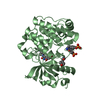
| ||||||||
| 3 | 
| ||||||||
| 4 | 
| ||||||||
| 5 | 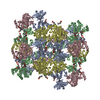
| ||||||||
| Unit cell |
| ||||||||
| Components on special symmetry positions |
|
- Components
Components
| #1: Protein | Mass: 35342.145 Da / Num. of mol.: 4 / Fragment: UNP residues 981-1286, IGF-1R Kinase domain Source method: isolated from a genetically manipulated source Source: (gene. exp.)  Homo sapiens (human) / Gene: IGF1R Homo sapiens (human) / Gene: IGF1RReferences: UniProt: P08069, receptor protein-tyrosine kinase #2: Chemical | ChemComp-575 / ( #3: Water | ChemComp-HOH / | Has protein modification | Y | |
|---|
-Experimental details
-Experiment
| Experiment | Method:  X-RAY DIFFRACTION / Number of used crystals: 1 X-RAY DIFFRACTION / Number of used crystals: 1 |
|---|
- Sample preparation
Sample preparation
| Crystal | Density Matthews: 2.61 Å3/Da / Density % sol: 52.83 % |
|---|---|
| Crystal grow | Temperature: 277 K / Method: vapor diffusion, hanging drop / pH: 8 Details: 0.1M Tris-HCl, pH8, 2M NaCl, 13-16% PEG6K, VAPOR DIFFUSION, HANGING DROP, temperature 277K |
-Data collection
| Diffraction | Mean temperature: 143 K |
|---|---|
| Diffraction source | Source:  SYNCHROTRON / Site: SYNCHROTRON / Site:  ALS ALS  / Beamline: 5.0.2 / Wavelength: 1 Å / Beamline: 5.0.2 / Wavelength: 1 Å |
| Detector | Type: ADSC QUANTUM 4 / Detector: CCD / Date: Jan 28, 2004 |
| Radiation | Protocol: SINGLE WAVELENGTH / Monochromatic (M) / Laue (L): M / Scattering type: x-ray |
| Radiation wavelength | Wavelength: 1 Å / Relative weight: 1 |
| Reflection | Resolution: 2.27→50 Å / Num. obs: 60396 / % possible obs: 90.8 % / Rmerge(I) obs: 0.096 |
| Reflection shell | Resolution: 2.45→2.56 Å / Rmerge(I) obs: 0.462 / Mean I/σ(I) obs: 1.8 / Num. unique all: 5939 / Rsym value: 0.462 / % possible all: 75.8 |
- Processing
Processing
| Software |
| |||||||||||||||||||||||||
|---|---|---|---|---|---|---|---|---|---|---|---|---|---|---|---|---|---|---|---|---|---|---|---|---|---|---|
| Refinement | Method to determine structure:  MOLECULAR REPLACEMENT MOLECULAR REPLACEMENTStarting model: PDB ENTRY 1JQH Resolution: 2.5→46.37 Å / Isotropic thermal model: isotropic / σ(F): 0 / Stereochemistry target values: Engh & Huber
| |||||||||||||||||||||||||
| Displacement parameters | Biso mean: 32.81 Å2 | |||||||||||||||||||||||||
| Refinement step | Cycle: LAST / Resolution: 2.5→46.37 Å
| |||||||||||||||||||||||||
| Refine LS restraints |
|
 Movie
Movie Controller
Controller



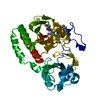
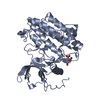

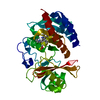

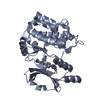
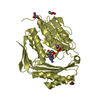

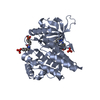
 PDBj
PDBj









